The Influence of Meteorology Initialization on Ozone Forecasting in the Great Lakes Region during MOOSE Study
Abstract
1. Introduction
2. Materials and Methods
2.1. Model Description
2.2. Simulations Setup
2.3. Observations
3. Results and Discussion
3.1. Impact of IAU Initialization
3.2. Impact of Initialization Time
4. Summary and Conclusions
Author Contributions
Funding
Institutional Review Board Statement
Informed Consent Statement
Data Availability Statement
Conflicts of Interest
References
- Foley, T.; Betterton, E.A.; Robert Jacko, P.E.; Hillery, J. Lake Michigan Air Quality: The 1994–2003 LADCO Aircraft Project (LAP). Atmos. Environ. 2011, 45, 3192–3202. [Google Scholar] [CrossRef]
- MOECC. Air Quality in Ontario Report. Ontario Ministry of the Environment and Climate Change. 2016. Available online: https://www.airqualityontario.com/press/publications.php (accessed on 24 August 2023).
- Makar, P.A.; Zhang, J.; Gong, W.; Stroud, C.; Sills, D.; Hayden, K.L.; Brook, J.; Levy, I.; Mihele, C.; Moran, M.D.; et al. Mass Tracking for Chemical Analysis: The Causes of Ozone Formation in Southern Ontario during BAQS-Met 2007. Atmos. Chem. Phys. 2010, 10, 11151–11173. [Google Scholar] [CrossRef]
- Stroud, C.A.; Ren, S.; Zhang, J.; Moran, M.D.; Akingunola, A.; Makar, P.A.; Munoz-Alpizar, R.; Leroyer, S.; Bélair, S.; Sills, D.; et al. Chemical Analysis of Surface-Level Ozone Exceedances during the 2015 Pan American Games. Atmosphere 2020, 11, 572. [Google Scholar] [CrossRef]
- Qin, M.; Yu, H.; Hu, Y.; Russell, A.G.; Odman, M.T.; Doty, K.; Pour-Biazar, A.; McNider, R.T.; Knipping, E. Improving Ozone Simulations in the Great Lakes Region: The Role of Emissions, Chemistry, and Dry Deposition. Atmos. Environ. 2019, 202, 167–179. [Google Scholar] [CrossRef]
- McNider, R.T.; Pour-Biazar, A.; Doty, K.; White, A.; Wu, Y.; Qin, M.; Hu, Y.; Odman, T.; Cleary, P.; Knipping, E.; et al. Examination of the Physical Atmosphere in the Great Lakes Region and Its Potential Impact on Air Quality—Overwater Stability and Satellite Assimilation. J. Appl. Meteorol. Climatol. 2018, 57, 2789–2816. [Google Scholar] [CrossRef]
- Brook, J.R.; Makar, P.A.; Sills, D.M.L.; Hayden, K.L.; McLaren, R. Exploring the Nature of Air Quality over Southwestern Ontario: Main Findings from the Border Air Quality and Meteorology Study. Atmos. Chem. Phys. 2013, 13, 10461–10482. [Google Scholar] [CrossRef]
- Koerber, M.; Kaleel, R.; Pocalujka, L.; Bruss, L. An Overview of the Lake Michigan Ozone Study. In Proceedings of the Seventh Joint Conference on Applications of Air Pollution Meteorology, New Orleans, LA, USA, 13–18 January 1991; pp. 260–263. [Google Scholar]
- Carroll, M.A.; Bertman, S.B.; Shepson, P.B. Overview of the Program for Research on Oxidants: PHotochemistry, Emissions, and Transport (PROPHET) Summer 1998 Measurements Intensive. J. Geophys. Res. Atmos. 2001, 106, 24275–24288. [Google Scholar] [CrossRef]
- Michigan-Ontario Ozone Source Experiment (MOOSE). 2021. Available online: https://www-air.larc.nasa.gov/missions/moose/ (accessed on 24 August 2023).
- Ehteram, M.; Najah Ahmed, A.; Khozani, Z.S.; El-Shafie, A. Graph Convolutional Network—Long Short Term Memory Neural Network- Multi Layer Perceptron- Gaussian Progress Regression Model: A New Deep Learning Model for Predicting Ozone Concertation. Atmos. Pollut. Res. 2023, 14, 101766. [Google Scholar] [CrossRef]
- Yafouz, A.; Ahmed, A.N.; Zaini, N.; Sherif, M.; Sefelnasr, A.; El-Shafie, A. Hybrid Deep Learning Model for Ozone Concentration Prediction: Comprehensive Evaluation and Comparison with Various Machine and Deep Learning Algorithms. Eng. Appl. Comput. Fluid Mech. 2021, 15, 902–933. [Google Scholar] [CrossRef]
- Fast, J.D.; Heilman, W.E. The Effect of Lake Temperatures and Emissions on Ozone Exposure in the Western Great Lakes Region. J. Appl. Meteorol. 2003, 42, 1197–1217. [Google Scholar] [CrossRef]
- Cleary, P.A.; Fuhrman, N.; Schulz, L.; Schafer, J.; Fillingham, J.; Bootsma, H.; McQueen, J.; Tang, Y.; Langel, T.; McKeen, S.; et al. Ozone Distributions over Southern Lake Michigan: Comparisons between Ferry-Based Observations, Shoreline-Based DOAS Observations and Model Forecasts. Atmos. Chem. Phys. 2015, 15, 5109–5122. [Google Scholar] [CrossRef]
- Simon, H.; Baker, K.R.; Phillips, S. Compilation and Interpretation of Photochemical Model Performance Statistics Published between 2006 and 2012. Atmos. Environ. 2012, 61, 124–139. [Google Scholar] [CrossRef]
- Zhang, T.; Xu, X.; Su, Y. Impacts of Regional Transport and Meteorology on Ground-Level Ozone in Windsor, Canada. Atmosphere 2020, 11, 1111. [Google Scholar] [CrossRef]
- Bloom, S.C.; Takacs, L.L.; da Silva, A.M.; Ledvina, D. Data Assimilation Using Incremental Analysis Updates. Mon. Weather Rev. 1996, 124, 1256–1271. [Google Scholar] [CrossRef]
- Buehner, M.; McTaggart-Cowan, R.; Beaulne, A.; Charette, C.; Garand, L.; Heilliette, S.; Lapalme, E.; Laroche, S.; Macpherson, S.R.; Morneau, J.; et al. Implementation of Deterministic Weather Forecasting Systems Based on Ensemble–Variational Data Assimilation at Environment Canada. Part I: The Global System. Mon. Weather Rev. 2015, 143, 2532–2559. [Google Scholar] [CrossRef]
- Lynch, P.; Huang, X. Initialization of the HIRLAM Model Using a Digital Filter. Mon. Weather Rev. 1992, 120, 1019–1034. [Google Scholar] [CrossRef]
- Fillion, L.; Mitchell, H.L.; Ritchie, H.; Staniforth, A. The Impact of a Digital Filter Finalization Technique in a Global Data Assimilation System. Tellus Dyn. Meteorol. Oceanogr. 1995, 47, 304. [Google Scholar] [CrossRef][Green Version]
- Caron, J.F.; Jacques, D.; Paquin-Ricard, D.; Faucher, M.; Milewski, T.; Verville, M. High Resolution Deterministic Prediction System–National Domain (HRDPS-NAT), Update from Version 5.2.0 to Version 6.0.0, Technical Note, December 2021, Canadian Centre for Meteorological and Environmental Prediction, Montreal, 45 pp. Available online: https://collaboration.cmc.ec.gc.ca/cmc/CMOI/product_guide/docs/tech_notes/technote_hrdps-600_e.pdf (accessed on 24 August 2023).
- Lee, M.-S.; Kuo, Y.-H.; Barker, D.M.; Lim, E. Incremental Analysis Updates Initialization Technique Applied to 10-Km MM5 and MM5 3DVAR. Mon. Weather Rev. 2006, 134, 1389–1404. [Google Scholar] [CrossRef]
- Ge, Y.; Lei, L.; Whitaker, J.S.; Tan, Z.-M. The Impact of Incremental Analysis Update on Regional Simulations for Typhoons. J. Adv. Model. Earth Syst. 2022, 14, e2022MS003084. [Google Scholar] [CrossRef]
- Polavarapu, S.; Ren, S.; Clayton, A.M.; Sankey, D.; Rochon, Y. On the Relationship between Incremental Analysis Updating and Incremental Digital Filtering. Mon. Weather Rev. 2004, 132, 2495–2502. [Google Scholar] [CrossRef]
- Yang, F. Comparison of Forecast Skills between NCEP GFS Four Cycles and on the Value of 06Z and 18Z Cycles. In Proceedings of the 27th Conference On Weather Analysis And Forecasting/23rd Conference On Numerical Weather Prediction, Chicago, IL, USA, 28 June–3 July 2015. [Google Scholar]
- Etherton, B.; Santos, P. J1. 8 The Effect of Local Initialization on Workstation ETA. Available online: https://www.academia.edu/download/38006271/67538.pdf (accessed on 30 August 2023).
- Caron, J.-F.; Milewski, T.; Buehner, M.; Fillion, L.; Reszka, M.; Macpherson, S.; St-James, J. Implementation of Deterministic Weather Forecasting Systems Based on Ensemble–Variational Data Assimilation at Environment Canada. Part II: The Regional System. Mon. Weather Rev. 2015, 143, 2560–2580. [Google Scholar] [CrossRef]
- Charron, M.; Polavarapu, S.; Buehner, M.; Vaillancourt, P.A.; Charette, C.; Roch, M.; Morneau, J.; Garand, L.; Aparicio, J.M.; MacPherson, S.; et al. The Stratospheric Extension of the Canadian Global Deterministic Medium-Range Weather Forecasting System and Its Impact on Tropospheric Forecasts. Mon. Weather Rev. 2012, 140, 1924–1944. [Google Scholar] [CrossRef]
- Côté, J.; Gravel, S.; Méthot, A.; Patoine, A.; Roch, M.; Staniforth, A. The Operational CMC–MRB Global Environmental Multiscale (GEM) Model. Part I: Design Considerations and Formulation. Mon. Weather Rev. 1998, 126, 1373–1395. [Google Scholar] [CrossRef]
- Côté, J.; Desmarais, J.-G.; Gravel, S.; Méthot, A.; Patoine, A.; Roch, M.; Staniforth, A. The Operational CMC–MRB Global Environmental Multiscale (GEM) Model. Part II: Results. Mon. Weather Rev. 1998, 126, 1397–1418. [Google Scholar] [CrossRef]
- Moran, M.D.; Ménard, S.; Talbot, D.; Huang, P.; Makar, P.A.; Gong, W.; Landry, H.; Gravel, S.; Gong, S.; Crevier, L.P.; et al. Particulate-Matter Forecasting with GEM-MACH15, a New Canadian Air-Quality Forecast Model; NATO Science for Peace and Security Series B-Physics and Biophysics; Springer: Berlin/Heidelberg, Germany, 2010. [Google Scholar]
- Moran, M.D.; Ménard, S.; Pavlovic, R.; Anselmo, D.; Antonopoulos, S.; Makar, P.A.; Gong, W.; Gravel, S.; Stroud, C.; Zhang, J.; et al. Recent Advances in Canada’s National Operational AQ Forecasting System. In Air Pollution Modeling and Its Application XXII; Steyn, D.G., Builtjes, P.J.H., Timmermans, R.M.A., Eds.; Springer: Dordrecht, The Netherlands, 2013; pp. 215–220. [Google Scholar]
- Pavlovic, R.; Chen, J.; Anderson, K.; Moran, M.D.; Beaulieu, P.-A.; Davignon, D.; Cousineau, S. The FireWork Air Quality Forecast System with Near-Real-Time Biomass Burning Emissions: Recent Developments and Evaluation of Performance for the 2015 North American Wildfire Season. J. Air Waste Manag. Assoc. 2016, 66, 819–841. [Google Scholar] [CrossRef]
- Makar, P.A.; Gong, W.; Milbrandt, J.; Hogrefe, C.; Zhang, Y.; Curci, G.; Žabkar, R.; Im, U.; Balzarini, A.; Baró, R.; et al. Feedbacks between Air Pollution and Weather, Part 1: Effects on Weather. Atmos. Environ. 2015, 115, 442–469. [Google Scholar] [CrossRef]
- Makar, P.A.; Gong, W.; Hogrefe, C.; Zhang, Y.; Curci, G.; Žabkar, R.; Milbrandt, J.; Im, U.; Balzarini, A.; Baró, R.; et al. Feedbacks between Air Pollution and Weather, Part 2: Effects on Chemistry. Atmos. Environ. 2015, 115, 499–526. [Google Scholar] [CrossRef]
- Gong, W.; Makar, P.A.; Zhang, J.; Milbrandt, J.; Gravel, S.; Hayden, K.L.; Macdonald, A.M.; Leaitch, W.R. Modelling Aerosol-Cloud-Meteorology Interaction: A Case Study with a Fully Coupled Air Quality Model (GEM-MACH). Atmos. Environ. 2015, 115, 695–715. [Google Scholar] [CrossRef]
- Mashayekhi, R.; Pavlovic, R.; Racine, J.; Moran, M.D.; Manseau, P.M.; Duhamel, A.; Katal, A.; Miville, J.; Niemi, D.; Peng, S.J.; et al. Isolating the Impact of COVID-19 Lockdown Measures on Urban Air Quality in Canada. Air Qual. Atmos. Health 2021, 14, 1549–1570. [Google Scholar] [CrossRef]
- Ren, S.; Stroud, C.; Belair, S.; Leroyer, S.; Munoz-Alpizar, R.; Moran, M.; Zhang, J.; Akingunola, A.; Makar, P. Impact of Urbanization on the Predictions of Urban Meteorology and Air Pollutants over Four Major North American Cities. Atmosphere 2020, 11, 969. [Google Scholar] [CrossRef]
- Masson, V.; Grimmond, C.S.B.; Oke, T.R. Evaluation of the Town Energy Balance (TEB) Scheme with Direct Measurements from Dry Districts in Two Cities. J. Appl. Meteorol. Climatol. 2002, 41, 1011–1026. [Google Scholar] [CrossRef]
- Sarrat, C.; Lemonsu, A.; Masson, V.; Guedalia, D. Impact of Urban Heat Island on Regional Atmospheric Pollution. Atmos. Environ. 2006, 40, 1743–1758. [Google Scholar] [CrossRef]
- Leroyer, S.; Bélair, S.; Mailhot, J.; Strachan, I.B. Microscale Numerical Prediction over Montreal with the Canadian External Urban Modeling System. J. Appl. Meteorol. Climatol. 2011, 50, 2410–2428. [Google Scholar] [CrossRef]
- Leroyer, S.; Bélair, S.; Spacek, L.; Gultepe, I. Modelling of Radiation-Based Thermal Stress Indicators for Urban Numerical Weather Prediction. Urban Clim. 2018, 25, 64–81. [Google Scholar] [CrossRef]
- Carrera, M.L.; Bélair, S.; Bilodeau, B. The Canadian Land Data Assimilation System (CaLDAS): Description and Synthetic Evaluation Study. J. Hydrometeorol. 2015, 16, 1293–1314. [Google Scholar] [CrossRef]
- APEI. Air Pollutant Emissions Inventory: Overview-Canada.Ca. 2020. Available online: https://www.canada.ca/en/environment-climate-change/services/pollutants/air-emissions-inventory-overview.html (accessed on 23 August 2023).
- U.S. EPA. 2016v1 Platform. 2021. Available online: https://www.epa.gov/air-emissions-modeling/2016v1-platform (accessed on 24 August 2023).
- UNC. CMAS: Community Modeling and Analysis System. 2014. Available online: https://www.cmascenter.org/smoke/ (accessed on 24 August 2023).
- Joe, P.; Belair, S.; Bernier, N.B.; Bouchet, V.; Brook, J.R.; Brunet, D.; Burrows, W.; Charland, J.-P.; Dehghan, A.; Driedger, N.; et al. The Environment Canada Pan and Parapan American Science Showcase Project. Bull. Am. Meteorol. Soc. 2018, 99, 921–953. [Google Scholar] [CrossRef]
- National Air Pollution Surveillance Program (NAPS). 2021. Available online: https://www.canada.ca/en/environment-climate-change/services/air-pollution/monitoring-networks-data/national-air-pollution-program.html (accessed on 24 August 2023).
- EPA AQS. 2021. Available online: https://www.epa.gov/aqs (accessed on 24 August 2023).
- Broder, B. Late Evening Ozone Maxima. Pure Appl. Geophys. 1981, 119, 978–989. [Google Scholar] [CrossRef]
- Zhang, R.; Lei, W.; Tie, X.; Hess, P. Industrial Emissions Cause Extreme Urban Ozone Diurnal Variability. Proc. Natl. Acad. Sci. USA 2004, 101, 6346–6350. [Google Scholar] [CrossRef]
- Petetin, H.; Thouret, V.; Athier, G.; Blot, R.; Boulanger, D.; Cousin, J.-M.; Gaudel, A.; Nédélec, P.; Cooper, O. Diurnal Cycle of Ozone throughout the Troposphere over Frankfurt as Measured by MOZAIC-IAGOS Commercial Aircraft. Elem. Sci. Anthr. 2016, 4, 000129. [Google Scholar] [CrossRef]
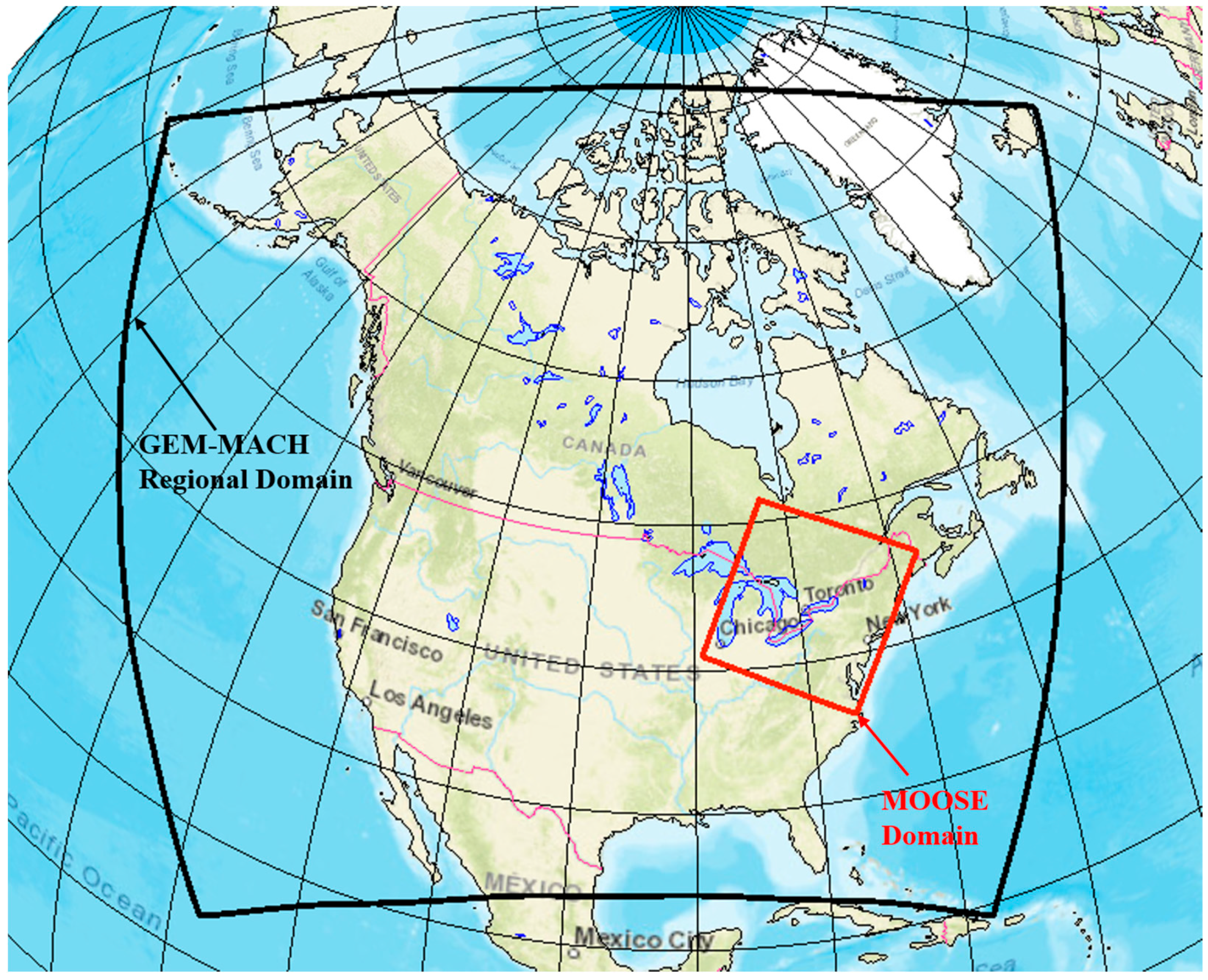
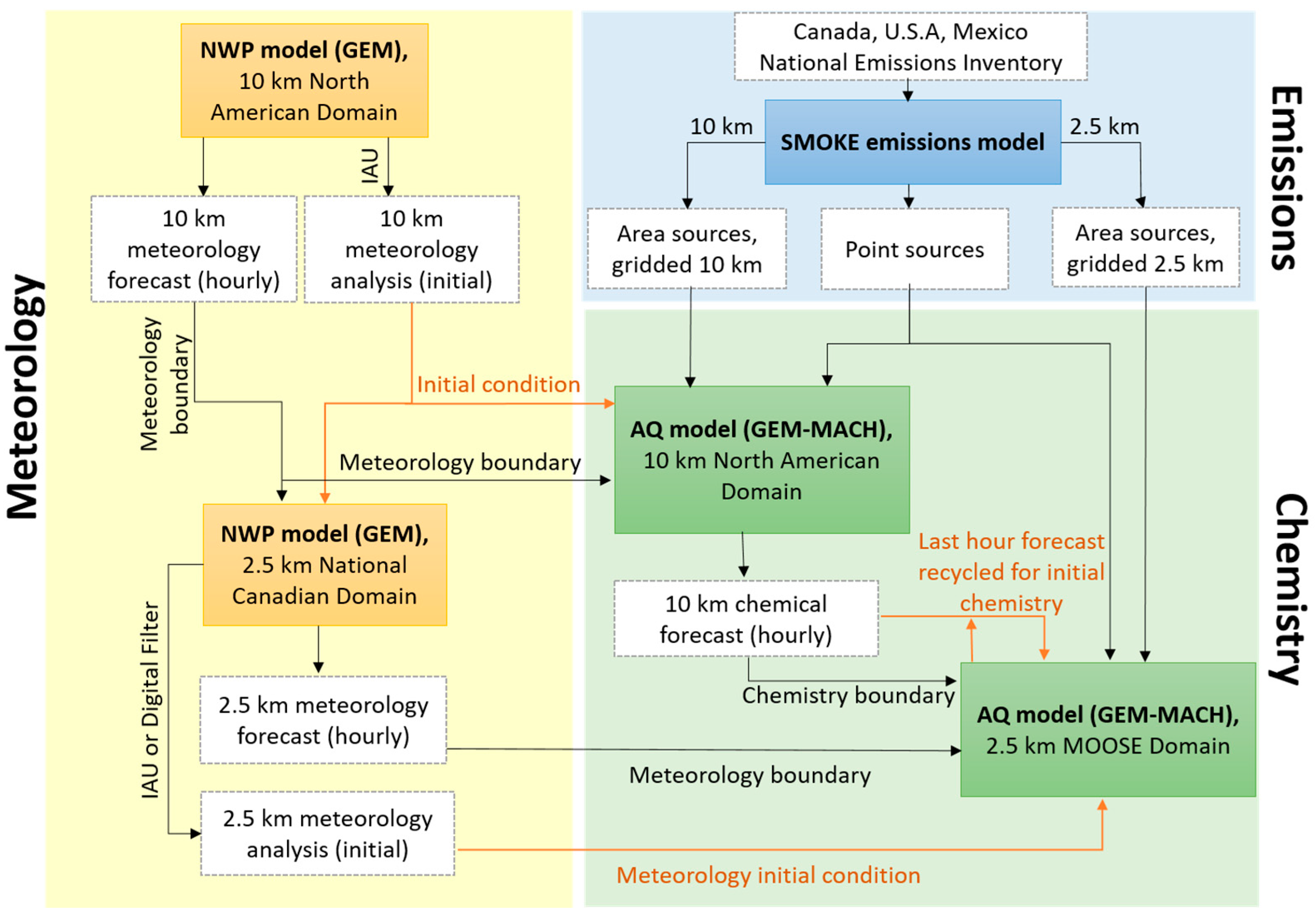
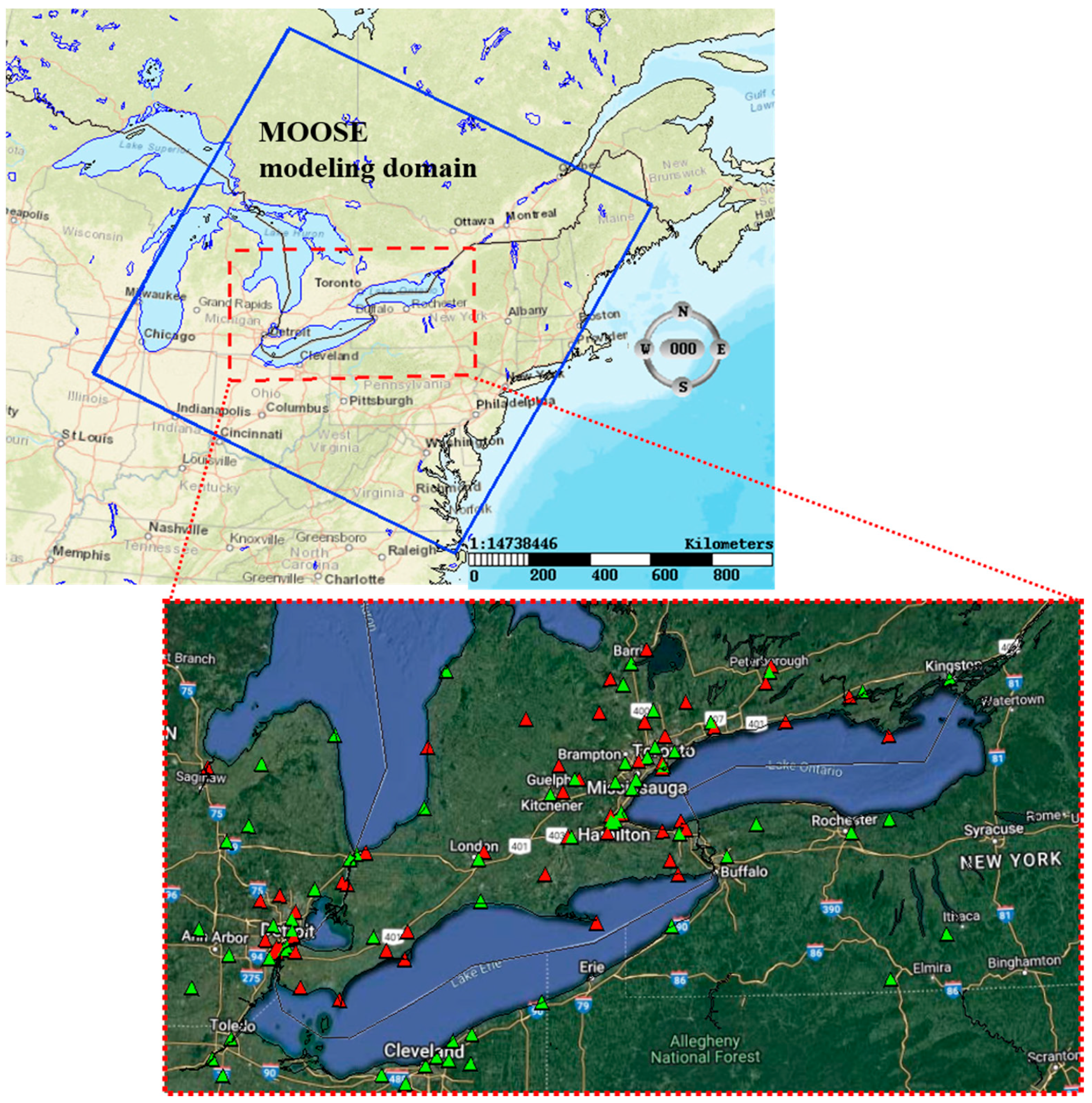

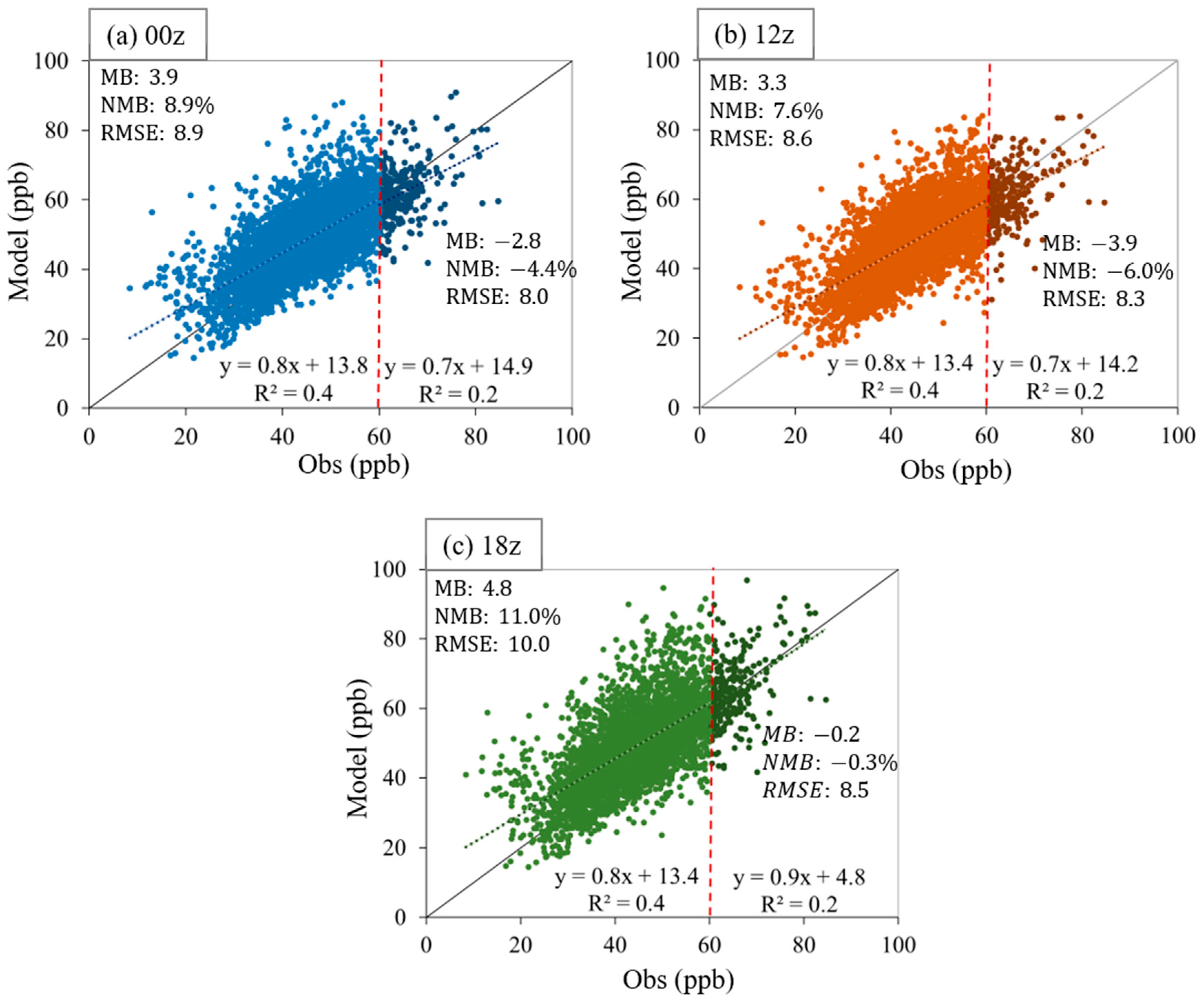
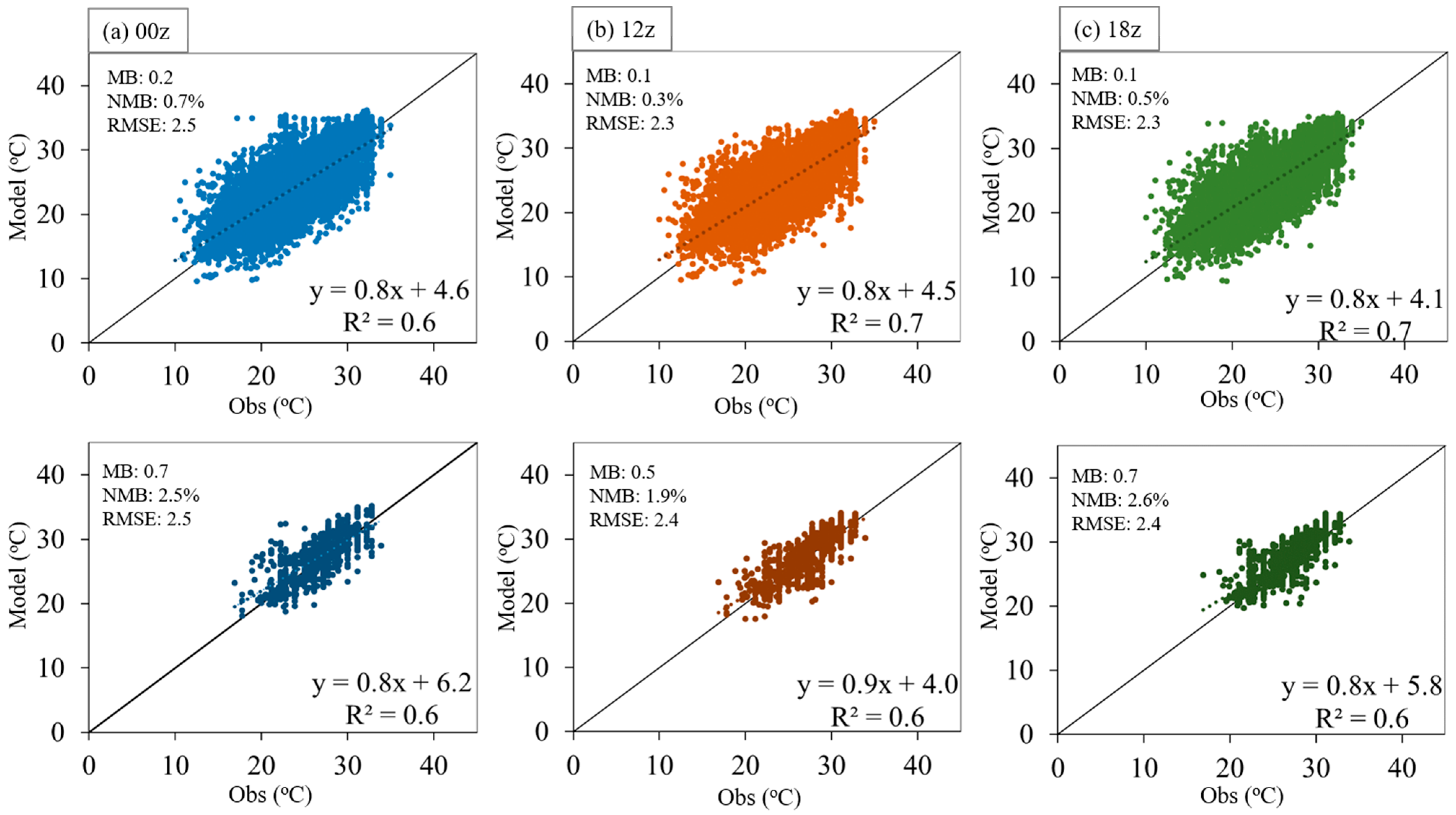

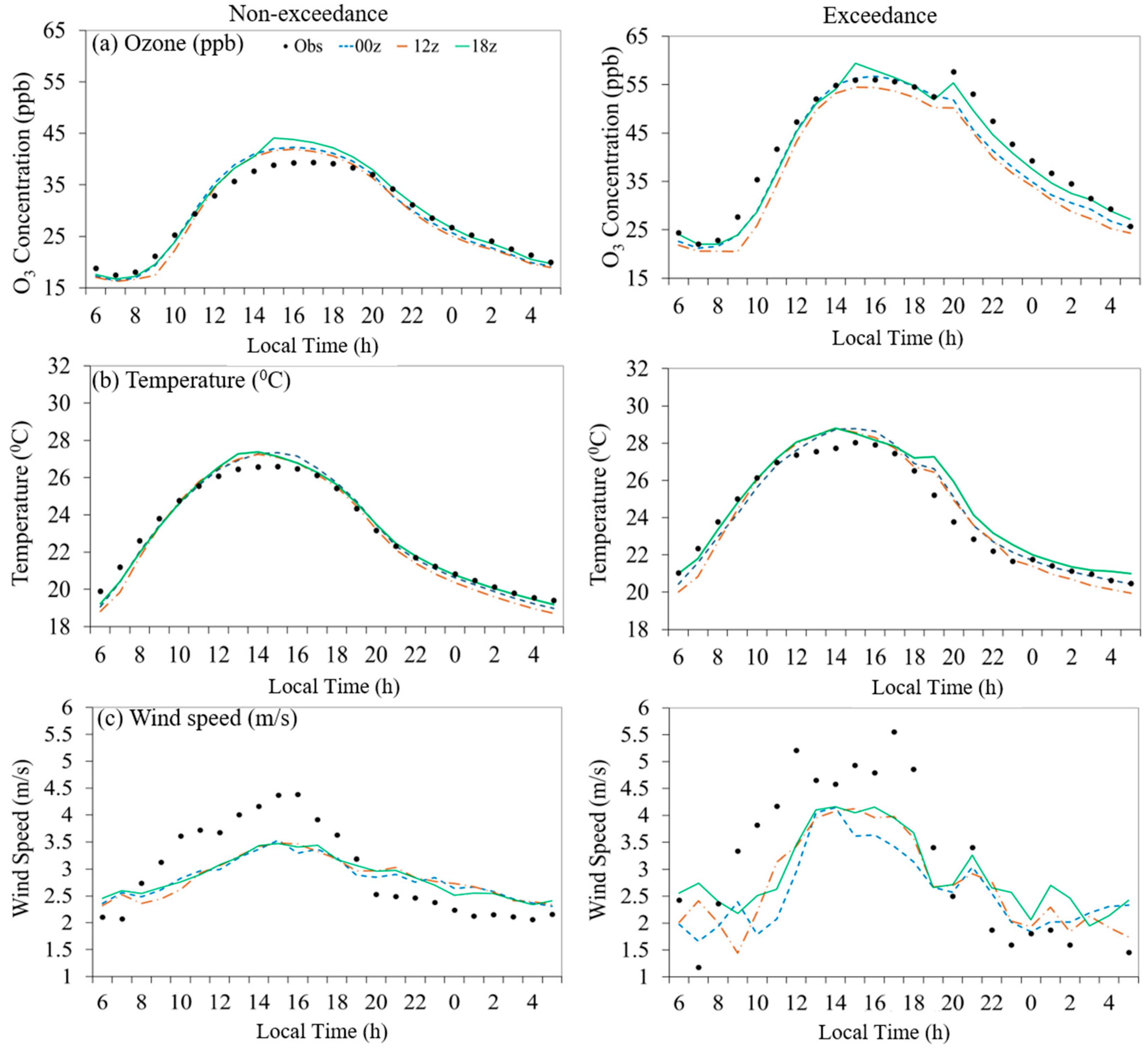
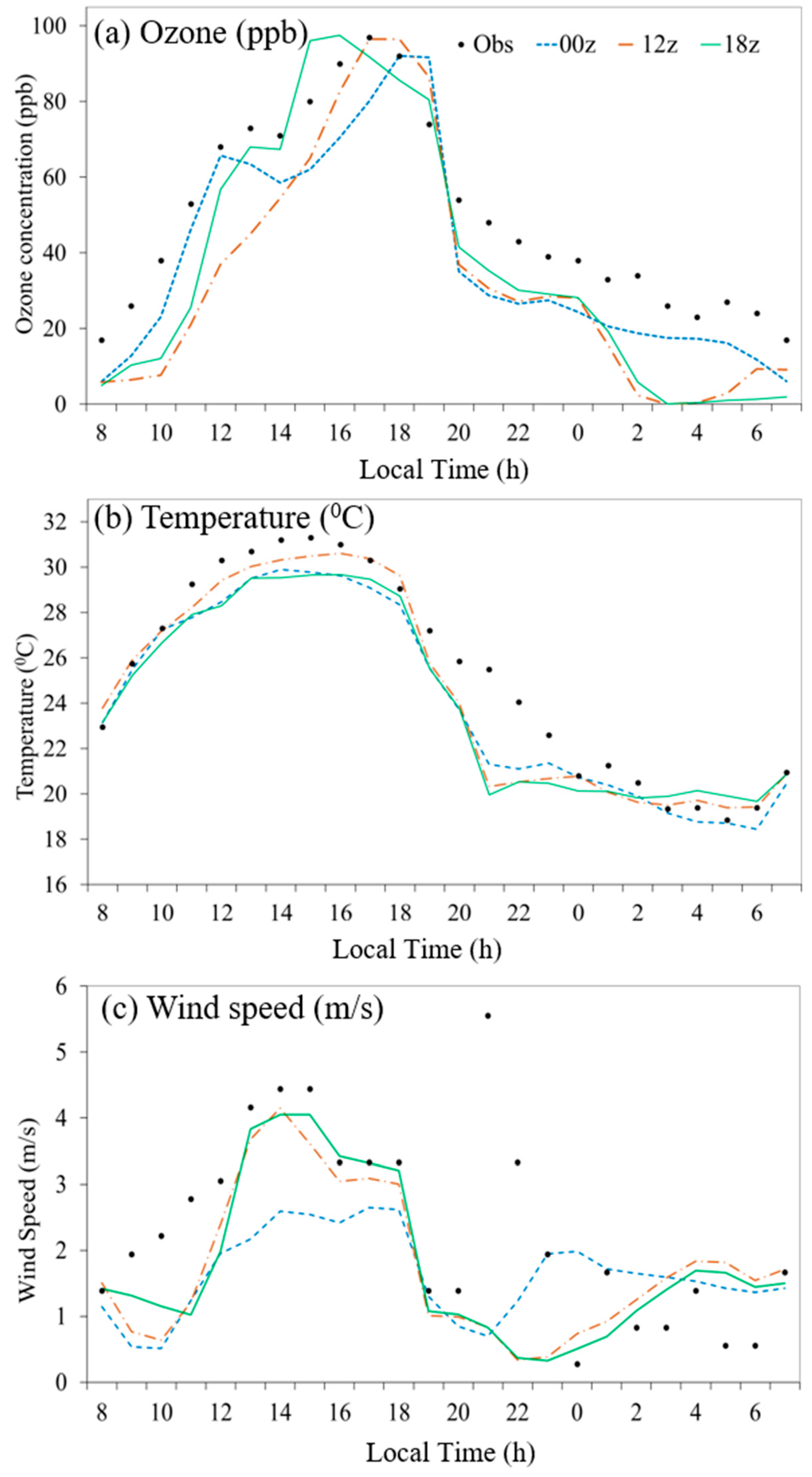

| Mean | Standard Deviation (SD) | Mean Bias | NMB (%) | RMSE | ||
|---|---|---|---|---|---|---|
| Temperature (°C) | Obs | 21.96 | 4.46 | |||
| IAU | 21.99 | 4.45 | 0.03 | 0.16 | 2.10 | |
| Non-IAU | 22.01 | 4.43 | 0.06 | 0.27 | 2.10 | |
| Wind speed (m/s) | Obs | 3.16 | 1.89 | |||
| IAU | 3.09 | 1.69 | −0.11 | −3.46 | 2.06 | |
| Non-IAU | 3.07 | 1.68 | −0.12 | −3.91 | 2.05 | |
| Wind direction (degree) | Obs | 207.50 | 96.32 | |||
| IAU | 204.96 | 95.26 | −1.50 | −0.72 | 130.19 | |
| Non-IAU | 204.62 | 95.35 | −1.82 | −0.88 | 130.31 |
Disclaimer/Publisher’s Note: The statements, opinions and data contained in all publications are solely those of the individual author(s) and contributor(s) and not of MDPI and/or the editor(s). MDPI and/or the editor(s) disclaim responsibility for any injury to people or property resulting from any ideas, methods, instructions or products referred to in the content. |
© 2023 by the authors. Licensee MDPI, Basel, Switzerland. This article is an open access article distributed under the terms and conditions of the Creative Commons Attribution (CC BY) license (https://creativecommons.org/licenses/by/4.0/).
Share and Cite
Mashayekhi, R.; Stroud, C.A.; Zhang, J.; Nikiema, O.; Trotechaud, S. The Influence of Meteorology Initialization on Ozone Forecasting in the Great Lakes Region during MOOSE Study. Atmosphere 2023, 14, 1383. https://doi.org/10.3390/atmos14091383
Mashayekhi R, Stroud CA, Zhang J, Nikiema O, Trotechaud S. The Influence of Meteorology Initialization on Ozone Forecasting in the Great Lakes Region during MOOSE Study. Atmosphere. 2023; 14(9):1383. https://doi.org/10.3390/atmos14091383
Chicago/Turabian StyleMashayekhi, Rabab, Craig A. Stroud, Junhua Zhang, Oumarou Nikiema, and Sandrine Trotechaud. 2023. "The Influence of Meteorology Initialization on Ozone Forecasting in the Great Lakes Region during MOOSE Study" Atmosphere 14, no. 9: 1383. https://doi.org/10.3390/atmos14091383
APA StyleMashayekhi, R., Stroud, C. A., Zhang, J., Nikiema, O., & Trotechaud, S. (2023). The Influence of Meteorology Initialization on Ozone Forecasting in the Great Lakes Region during MOOSE Study. Atmosphere, 14(9), 1383. https://doi.org/10.3390/atmos14091383







